Breadcrumb
Blogs
Entries with Categories Global Affairs work documents .
![US X unmanned space plane, returning from its fourth mission, in 2017 [US Air Force]. US X unmanned space plane, returning from its fourth mission, in 2017 [US Air Force].](/documents/10174/16849987/gaj-foto-2.jpg)
▲ US X unmanned space plane, returning from its fourth mission, in 2017 [US Air Force].
GLOBAL AFFAIRS JOURNAL / Luis V. Pérez Gil
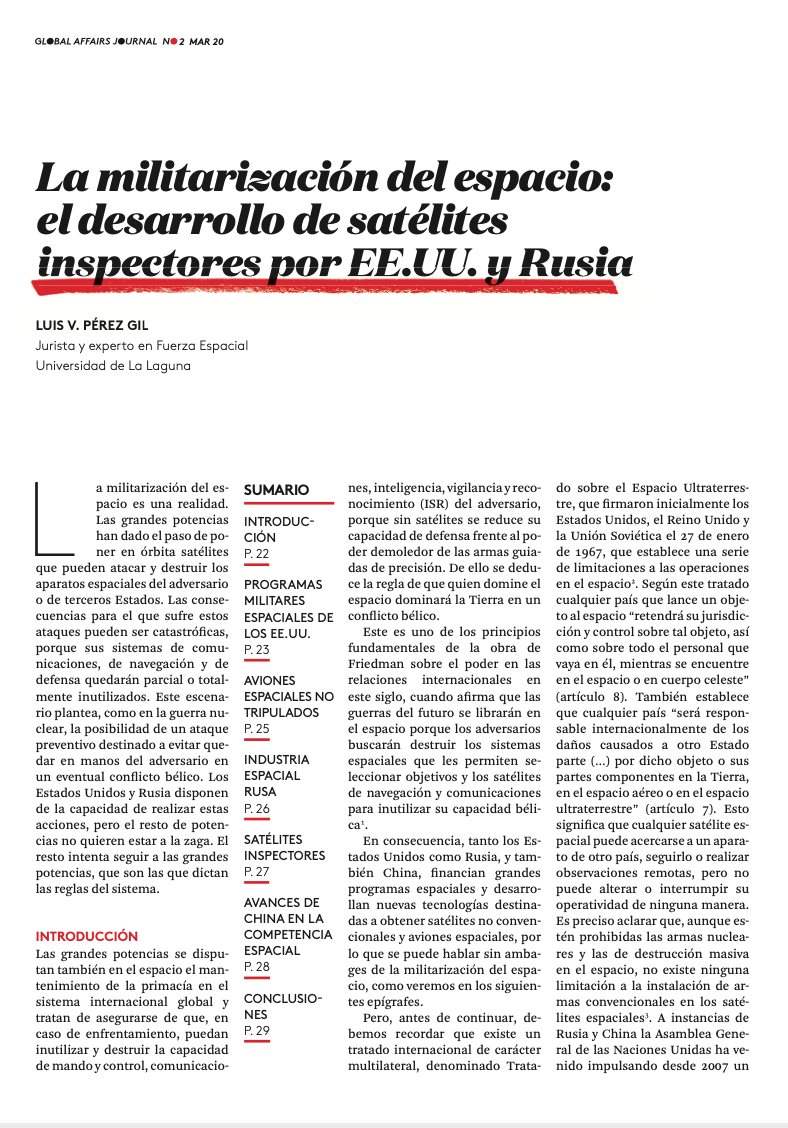 [10-page document. download in PDF]
[10-page document. download in PDF]
INTRODUCTION
The militarization of space is a reality. The major powers have taken the step of putting satellites into orbit that can attack and destroy the space apparatus of the adversary or third States. The consequences for those who suffer these attacks can be catastrophic, because their communications, navigation and defense systems will be partially or totally disabled. This scenario raises, as in nuclear war, the possibility of a preemptive attack aimed at avoiding being in the hands of the adversary in an eventual war. The United States and Russia have the capability to carry out such actions, but the other powers do not want to lag behind. The rest are trying to follow the great powers, who dictate the rules of the system.
The great powers also compete in space to maintain their primacy in the global international system and try to ensure that, in the event of a confrontation, they can disable and destroy the adversary's command and control, communications, intelligence, surveillance and reconnaissance (ISR) capabilities, because without satellites their ability to defend themselves against the demolishing power of precision-guided weapons is reduced. From this follows the rule that whoever dominates space will dominate the Earth in a war.
This is one of the fundamental tenets of Friedman's work on power in international relations in this century, when he states that the wars of the future will be fought in space because adversaries will seek to destroy the space systems that allow them to select targets and the navigation and communications satellites to disable their warfare capabilities.
As a result, both the United States and Russia, as well as China, are financing large space programs and developing new technologies aimed at obtaining unconventional satellites and space planes, so that we can speak unequivocally of the militarization of space, as we shall see in the following sections.
But, before continuing, we must remember that there is a multilateral international treaty, called the Outer Space Treaty, initially signed by the United States, the United Kingdom and the Soviet Union on January 27, 1967, which establishes a series of limitations to operations in space. According to this treaty, any country launching an object into space "shall retain jurisdiction and control over such object, as well as over all staff carried thereon, while in space or in a celestial body"article 8). It also establishes that any country "shall be internationally manager for damage caused to another State party (...) by such an object or its component parts on Earth, in airspace or outer space"article 7). This means that any space satellite may approach a device of another country, follow it or make remote observations, but may not alter or interrupt its operability in any way. It should be clarified that, although nuclear weapons and weapons of mass destruction are prohibited in space, there is no limitation on the installation of conventional weapons on space satellites. At the urging of Russia and China, the United Nations General Assembly has been pushing since 2007 for a project multilateral treaty banning weapons in outer space, the use of force or the threat of force against space objects, but it has been systematically rejected by the United States.
![In addition to the return to the Moon and the arrival on Mars, asteroid travel programs are also accelerated [NASA]. In addition to the return to the Moon and the arrival on Mars, asteroid travel programs are also accelerated [NASA].](/documents/10174/16849987/gaj-foto-1.jpg)
▲ In addition to Moon return and Mars landings, asteroid travel programs also accelerate [NASA].
GLOBAL AFFAIRS JOURNAL / Javier Gómez-Elvira
 [8-page document. download in PDF]
[8-page document. download in PDF]
INTRODUCTION
Since time immemorial, human beings have imagined themselves outside the Earth, exploring other worlds. One of the first stories dates back to the second century A.D. Lucian of Samosata wrote a book in which his characters reached the Moon thanks to the impulse of a whirlwind and there they developed their adventures. Since then, numerous science fiction novels or stories can be found that take place on the Moon, Mars, other bodies of our Solar System or even beyond. Somehow all of them lost a bit of their fiction in the middle of the last century, with the first steps of an astronaut on our satellite. Unfortunately, what seemed to be the beginning of a new era did not go beyond 5 missions in 2 years.
The first stage began when President Kennedy uttered his famous phrase: "We choose to go to the Moon.... We choose to go to the Moon in this decade and do the other things, not because they are easy, but because they are hard; because that goal will serve to organize and measure the best of our energies and skills, because that challenge is one that we are willing to accept, one we are unwilling to postpone, and one we intend to win, and the others, too". Although perhaps the end was written in the beginning: the only goal was to demonstrate that the US was the technological leader over the USSR, and when this was achieved the project was stopped.
![Scene about anchoring on an asteroid to develop mining activity, from ExplainingTheFuture.com [Christopher Barnatt]. Scene about anchoring on an asteroid to develop mining activity, from ExplainingTheFuture.com [Christopher Barnatt].](/documents/10174/16849987/gaj-foto-0.jpg)
▲ Scene about anchoring on an asteroid to develop mining activity, from ExplainingTheFuture.com [Christopher Barnatt].
GLOBAL AFFAIRS JOURNAL / Emili J. Blasco
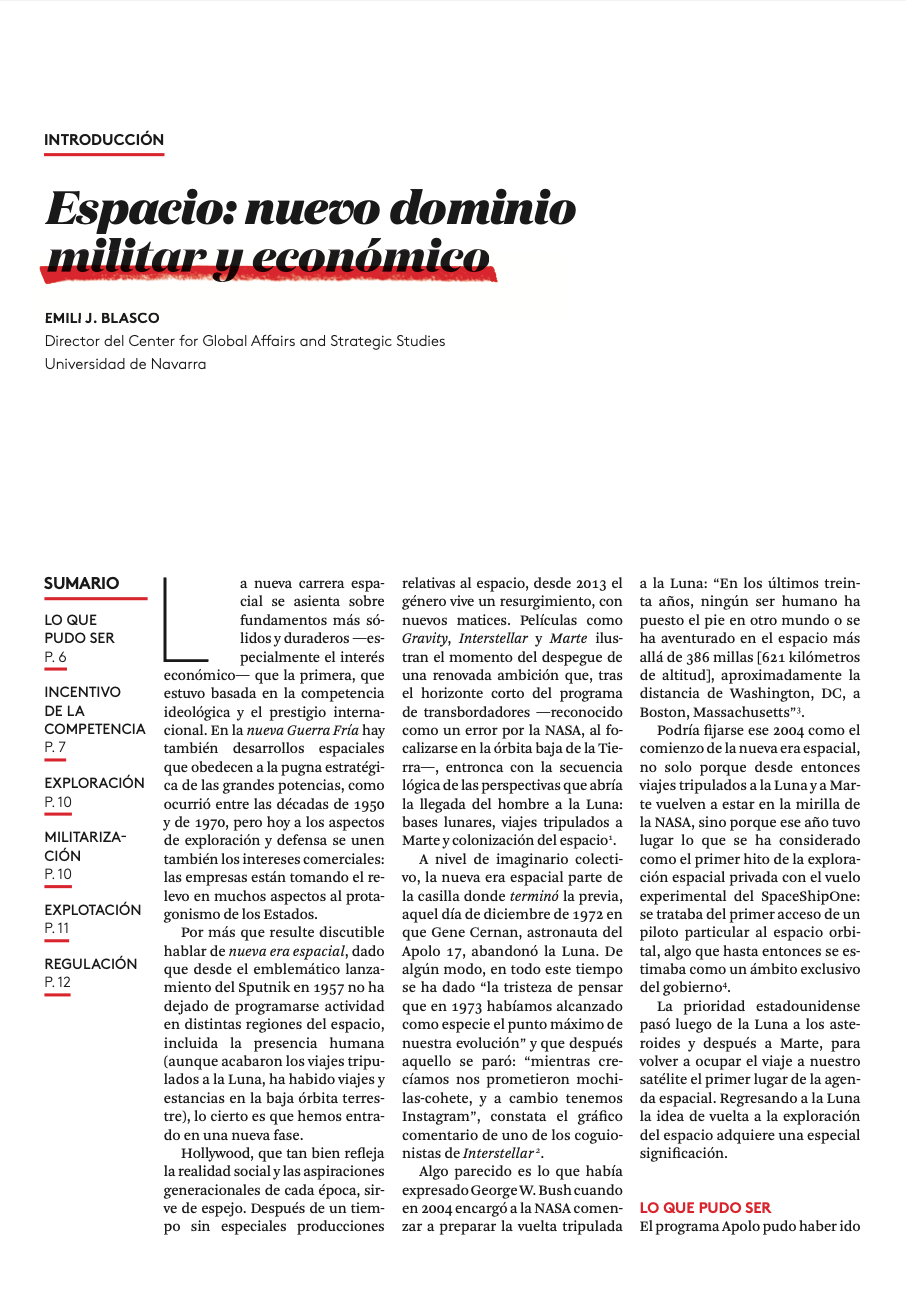 [8-page document. download in PDF]
[8-page document. download in PDF]
INTRODUCTION
The new space degree program is based on more solid and lasting foundations -especially economic interests- than the first one, which was based on ideological skill and international prestige. In the new Cold War there are also space developments that obey the strategic struggle of the great powers, as occurred between the 1950s and 1970s, but today the exploration and defense aspects are joined by commercial interests: companies are taking over in many aspects from the protagonism of the States.
However debatable it may be to speak of a new space age, given that since the emblematic launch of Sputnik in 1957, there has been no end to programmed activity in different regions of space, including human presence (although manned trips to the Moon have ended, there have been trips and stays in the Earth's leave ), the truth is that we have entered a new phase.
Hollywood, which so well reflects the social reality and generational aspirations of each time, serves as a mirror. After a time without special space-related productions, since 2013 the genre is experiencing a resurgence, with new nuances. Films such as Gravity, Interstellar and Mars illustrate the moment of takeoff of a renewed ambition that, after the short horizon of the shuttle program - recognized as a mistake by NASA, as it focused on the Earth's orbit leave -, connects with the logical sequence of the perspectives opened by the arrival of man on the Moon: lunar instructions , manned trips to Mars and space colonization.
At the level of the collective imagination, the new space age starts from the square where the previous one "ended", that day in December 1972 when Gene Cernan, Apollo 17 astronaut, left the Moon. Somehow, in all this time there has been "the sadness of thinking that in 1973 we had reached the peak of our evolution as a species" and that later it stopped: "while we were growing up we were promised rocket backpacks, and in exchange we got Instagram", states the graphic commentary of one of the co-writers of Interstellar.
Something similar is what George W. Bush had expressed when in 2004 he commissioned NASA to start preparing for man's return to the Moon: "In the last thirty years, no human being has set foot on another world or ventured into space beyond 386 miles [621 kilometers in altitude], roughly the distance from Washington, DC, to Boston, Massachusetts".
The year 2004 could be considered the beginning of the new space age, not only because manned trips to the Moon and Mars have been back in NASA's sights since then, but also because it was the first milestone in private space exploration with the experimental flight of SpaceShipOne: it was the first access of a private pilot to orbital space, something that until then had been considered the exclusive domain of the government.
The American priority then went from the Moon to some of the asteroids and then to Mars, to return to the trip to our satellite to occupy the first place in the space diary . Returning to the Moon, the idea of a "return" to space exploration takes on a special significance.
WORKING PAPER / Marianna McMillan
ABSTRACT
In appearance the internet is open and belongs to no one, yet in reality it is subject to concentrated tech firms that continue to dominate content, platform and hardware. This paper intends to highlight the importance in preventing any one firm from deciding the future, however this is no easy feat considering both: (i) the nature of the industry as ambiguous and uncertain and (ii) the subsequent legal complexities in defining the relevant market to assess and address their dominance without running the risk of hindering it. Thus, the following paper tries to fill the gap by attempting to provide a theoretical and practical examination of: (1) the nature of the Internet; (2) the nature of monopolies and their emergence in the Internet industry; and (3) the position of the US in contrast to the EU in dealing with this issue. In doing so, this narrow examination illustrates that differences exist between these two regimes. Why they exist and how they matter in the Internet industry is the central focus.
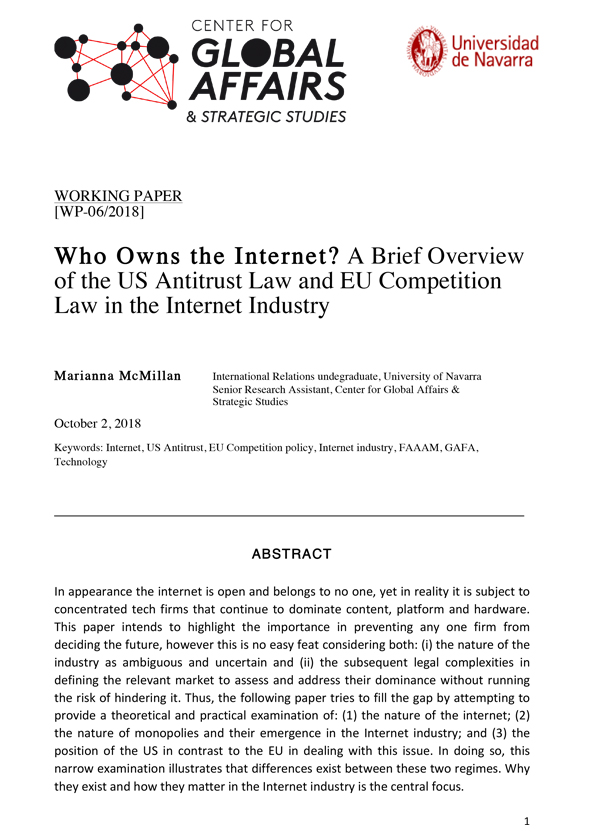 Download the document [pdf. 387K]
Download the document [pdf. 387K]
WORKING PAPER / N. Moreno, A. Puigrefagut, I. Yárnoz
ABSTRACT
The fundamental characteristic of the external action of the European Union (EU) in recent years has been the use of the so-called soft power. This soft power has made the Union a key actor for the development of a large part of the world's regions. The last decades the EU has participated in a considerable amount of projects in the economic, cultural and political fields in order to fulfil the article 2 of its founding Treaty and thus promote their values and interests and contribute to peace, security and sustainable development of the globe through solidarity and respect for all peoples. Nevertheless, EU's interventions in different regions of the world have not been free of objections that have placed in the spotlight a possible direct attack by the Union to the external States' national sovereignties, thus creating a principle of neo-colonialism by the EU.
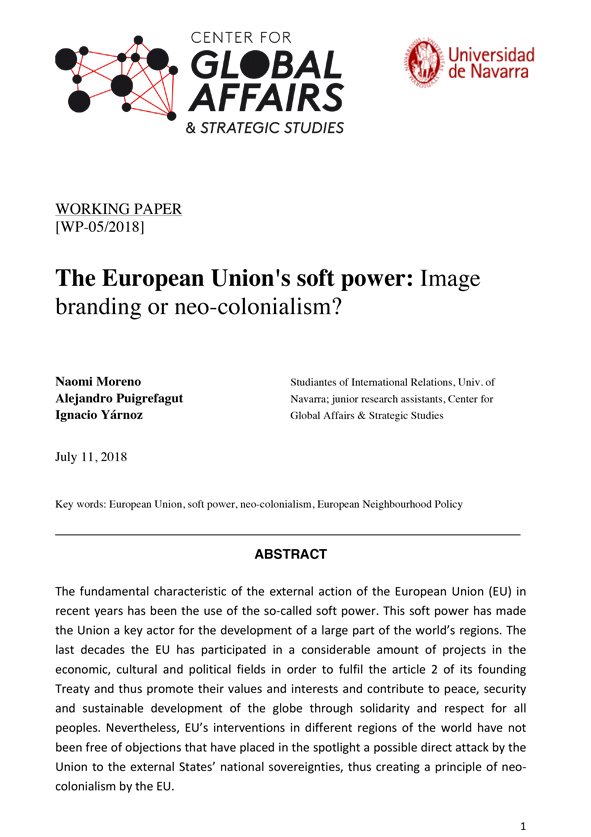 Download the document [pdf. 548K]
Download the document [pdf. 548K]
DOC. DE work / A. Palacios, M. Lamela, M. Biera[English version].
SUMMARY
The European Union (EU) has been particularly damaged internally by disinformation campaigns that have questioned its legislation and its very values. The various disinformation operations and the inability of the EU institutions to communicate have generated a sense of alarm in Brussels. Barely a year before the European Parliament elections, Europe has concentrated many of its efforts on tackling the disinformation challenge, generating new strategies and work groups such as the Stratcom Task Force or the European Commission's group of experts.
 download the complete document [pdf. 381K]
download the complete document [pdf. 381K]
DOCUMENTO DE work / María Granados Machimbarrena
SUMMARY
Despite the HIRSI AND JAMAA judgment of 2012, Italy was condemned in 2015 once again by the European Court of Human Rights for unlawful detention and summary and collective refoulement of several migrants. The events occurred in 2011, when the applicants traveled in a boat across the Mediterranean and were intercepted by Italian vessels. The migrants were transferred to the island of Lampedusa, and detained at the Centro di Soccorso e Prima Accoglienza (CSPA), in an area reserved for Tunisian nationals. According to the plaintiffs, they were detained in overcrowded and dirty rooms, with no contact with the outside. The events took place immediately after the Arab Spring. The issues raised before the Court by the applicants and the arguments raised by the judges are relevant in the current context of the European crisis in the management of refugee flows by the EU institutions and its Member States.
 download the complete document [pdf. 6.4MB]
download the complete document [pdf. 6.4MB]
DOCUMENTO DE work / Lucía Serrano Royo
SUMMARY
The European Union was born as a mechanism for cooperation between countries, but its recent history makes the system still very fragile. At the same time, its diversity makes decision making complex and many political interests come into play, which may conflict with each other. One of the most relevant events that is currently taking place and that has shaken the pillars of the Union is "Brexit", the exit of the United Kingdom as a member state of the Union. This paper will analyze the slow implementation of article 50 of the Treaty on European Union, which is activated for the first time in history. In addition, it analyzes the reasons in the European and internal context that have led to this status and the consequences from a political, economic and social point of view. Faced with this climate of instability and uncertainty, different alternatives to this status will be proposed and it will be analyzed how the European Union has responded to this problem in its White Paper, where different scenarios for the continuation of the Union have been established.
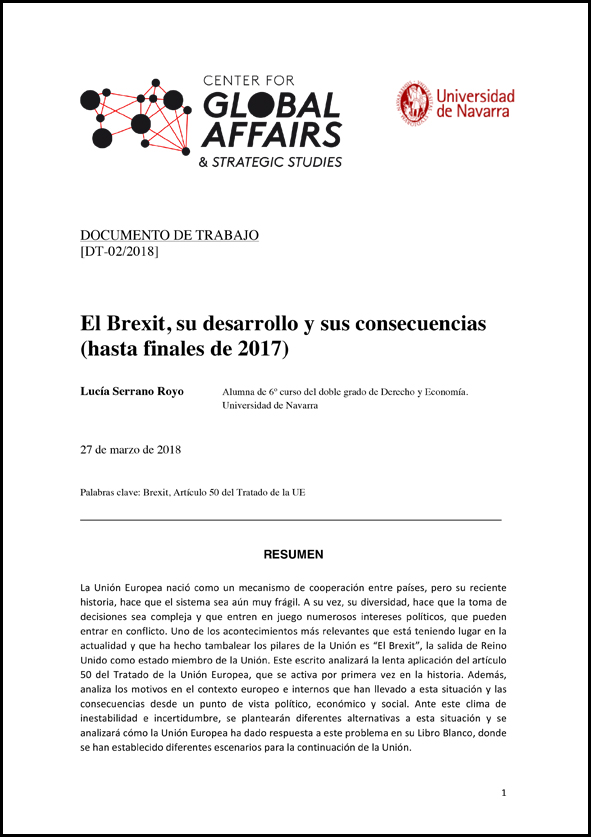 download the complete document [pdf. 4.4MB]
download the complete document [pdf. 4.4MB]
DOC. DE work / Iñigo González Inchaurraga
SUMMARY
The main, though not the only, element of contention between the United States and China is Taiwan. While Washington maintains a one-China policy, Beijing defends the "one China" principle, proclaiming that there is only one China in the world and that both the island of Taiwan and the mainland are the same People's Republic of China. The Chinese authorities also maintain that Chinese sovereignty and territory cannot be divided. In Beijing's eyes, Taiwan is a renegade province that emerged from the Chinese civil war, so reunification is the only option for the island's future. This reunification should preferably take place peacefully, but the use of force cannot be ruled out if Taiwan were to seek de jure independence. For its part, the government of Taipei claims its status as a sovereign state. The fact is that at the end of the 2010s, it is difficult to continue asking China to comply with international law in relation, for example, to the Permanent Court of Arbitration ruling and territorial disputes in the South China Sea, while Taiwan remains an anomaly that violates the same international law that Beijing must comply with in accordance with UN rules on the Law of the Sea.
 download the complete document [pdf. 432k]
download the complete document [pdf. 432k]
Showing 11 to 19 of 19 entries.
